 EN
EN
 PT
PT
Reading, comprehension, writing, grammar, spelling and lexis
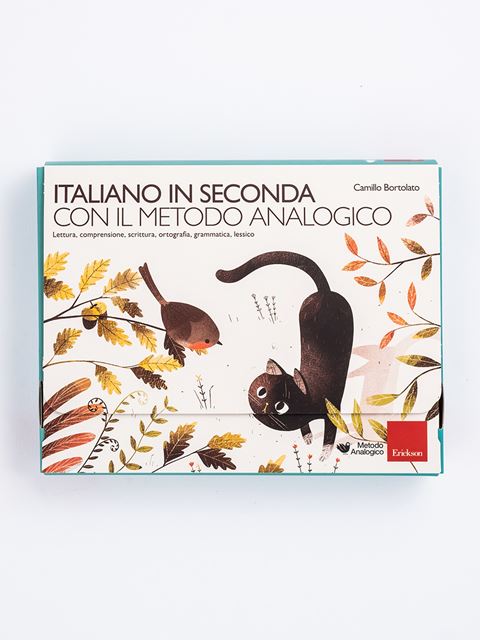
Product: Book
Pages: 8 desk strips + strip holder + book “20 stories + Luna” + writing exercise book + fiber pen + guide for teachers
ISBN: 9788859013471
Publication date: 01/05/2017
Suitable for: Primary 1st level (ages 6-7)
REQUEST A SAMPLE OR MORE INFORMATION
An innovative proposal for applying the analogical method to teaching/learning Italian in year two of primary school.
In order to enable children to learn to read right from the beginning the entire alphabet is presented, together with digraphs and trigraphs, which from word groups turn into icons, so that they can be more easily memorised, identified and decoded. Learning to write however takes longer and occurs following precise indications.
Year two Italian with the Analogical Method comprises:
8 DESK STRIPS
1) Writing 2) Handwriting keyboard 3) Instant spelling 4) Apostrophes/accents 5) Putting together 6) Narrating/ describing 7) Instant grammar 8) Final quiz
THE STORY BOOK «20 STORIES PLUS LUNA»
A storybook which contains more than 20 stories allowing children to practice reading and text comprehension.
DESK STRIP HOLDER: a tool which has the dual purpose of holding all the strips and keeping them visible on the desk; you can write on it like a erasable whiteboard.
THE WRITING EXERCISE BOOK
An exercise book for practising writing and also first attempts at text production. It contains exercises and games for learning how to:
– handwrite well;
– write without making mistakes;
– put together thoughts, sentences and stories.
THE GUIDE
Instructions on how to use the kit at school and at home, for teachers and parents.
Box with:
- 8 strips
- strip holder
- book “20 stories + Luna”
- exercise book
- marker pen
- teacher's guide

Reading for the pleasure of reading and writing for the pleasure of writing
«Learning to love reading, to write well and properly and to produce stories that talk about the children's own life is the programme for year two Italian in brief. The activities performed one by one will then be harmonised in the children's mind, who suddenly find themselves competent almost without actually noticing».
Camillo Bortolato
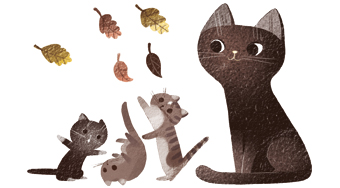
“Year Two Italian with the Analogical Method” is a box which contains all the necessary tools for learning reading and writing in primary year two: a writing exercise book for writing correctly, producing stories and approaching grammatical analysis for the first time, 8 strips for consolidating learning and a strip holder to hold the strips; an erasable felt pen for writing on transparent film and lastly a guide for teachers and parents on how to use the kit.
ALL THE TOOLS CONTAINED IN THE BOX:
THE STORY BOOK «20 STORIES PLUS LUNA»
It is a reader which is the same for the whole class so that narrative events, dealing especially with emotions, can be shared. An essential feature is that compared to ordinary readers it avoids the fragmentation and instrumental use of reading passages.
It comprises 20 stories, which are mainly taken from popular tradition, preceded by a longer story, divided into 23 chapters, whose main character is Luna the cat. All in all there are 43 stories or episodes, which can be considered learning units.

The reader starts with the main story. The adventures of Pitti the Robin, which started in nursery school with «Pitti's little story» and continued in primary year one with «Pitti's seasons» resume (all stories which can also be used independently).
At the end of each chapter in the story a few simple tasks are set, like doing a drawing or explaining key points in the story (descriptions, dialogues, feelings etc.)
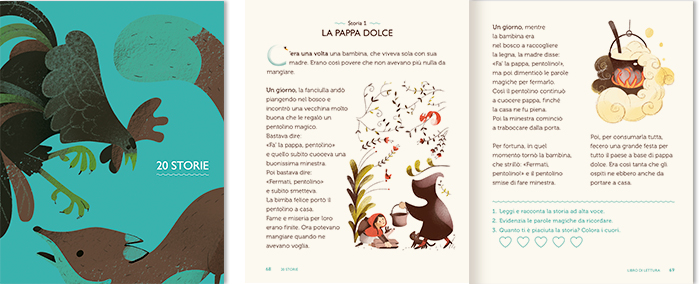
20 stories taken from popular tradition, which almost always start with the formula «Once upon a time». A ritualistic beginning which transports the reader into timelessness and the world of archetypes that belong to everyone. Each story ends with two tasks: «Read and tell the story out loud» and «How much did you enjoy this?». There are no comprehension questions here either, because the task of telling the story out loud summarises it all.
THE WRITING EXERCISE BOOK
After the reading phase, in which children learn to appreciate stories invented by other people, you move onto the writing phase, in which children learn to write their own. Tasks in the exercise book are divided into three phases, devoted to handwriting, production, and spelling and grammatical accuracy, respectively.
Writing well
In the first part of the exercise book there are exercises on joined-up writing, useful for children who present deficiencies or who are attempting this kind of writing for the first time in year two. It starts with easy copying exercises, where pupils have no other mental task than to proceed slowly along the lines of the exercise book, as if they were railway tracks.
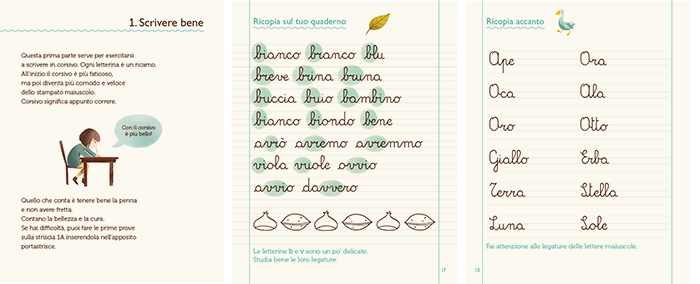
Producing
After dedicating a couple of weeks to handwriting, children move on to producing thoughts and stories. The novelty of the analogical approach consists in presenting textual models and not theoretical explanations. Thus, once again, learning by imitation and this time using joined up writing, as this is the way we write.
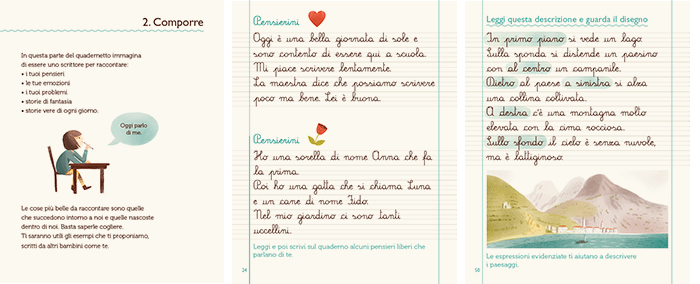
Grammar
The third section of the exercise book is devoted initially to encouraging spelling accuracy and then offers a first approach to grammatical analysis. For the spelling part the rules, as always, will be perceived or better intuited «as you go along», in other words as needed. So not before starting, when there is still no need. Towards the end of the section there are some activities in which pupils look for errors in a text in the same way as a teacher would. This is because the idea of looking for other people's mistakes boosts our attention.
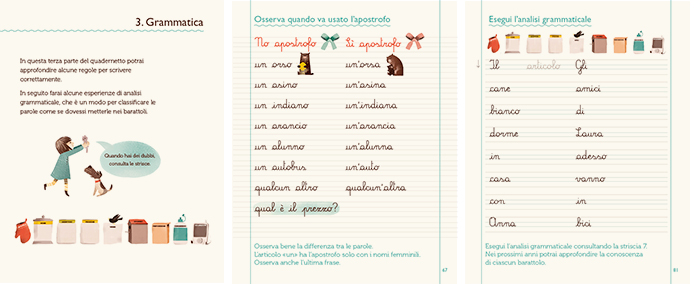
8 DESK STRIPS
The eight strips are like a depository of learning, they are the starting point and the finish line, because in the analogical method you start from the end, in other words from contemplating the task to be done.
Here is how to use the 8 strips
Strip 1: Handwriting/Animal shapes
• Trace the letters and words with a felt pen all in one go.
• Trace animal shapes, useful for acquiring procedural models for drawing.


Strip 2: Handwriting keyboard/Joined-up writing
• Pronounce the names of the images in the lower strip and «type» them with your finger on the keyboard. It's an activity which develops the use of digraphs and trigraphs.
• Revise words containing difficult sounds in order to fix them to memory.


Strip 3: Quick spelling
• Revise spelling difficulties through a chorus reading activity which lasts a couple if minutes.


Strip 4: Apostrophes/Accents
• Study all the problem areas together and repeat them on different days.


Strip 5: Producing
• Examine the strip on both sides and answer any questions the child might ask with examples of sentences.


Strip 6: Narrating and describing
• Simply read the whole strip all together or individually, explaining that the description in the stories corresponds to pausing the narrative thread.
• Leave it down to spontaneity seeing as we are dealing with initial inputs which will go on to be developed.


Strip 7: Quick grammar
• On the first day get children to complete the task on both sides and then to rub it out.
• Repeat the exercise on other days.
• Engage children orally to find the right jar for other words given by the teacher.
• Explain to the class that the jar game is just the start and that it will be further developed, becoming even more fun.


Strip 8: Final quiz
• Complete the exercise all in one go, several times, in order to achieve total competence. In the event of difficulties repeat the previous strips (in particular strip 3).


Left-handed strips
For children who encounter objective difficulties moving the felt pen towards the right without smudging what they have already written, a solution - to be decided by the teacher or parent - could be to rewrite some of the strips vertically and to position the strip holder vertically too.
Discover the other books and tools of the Bortolato Analogical Method »